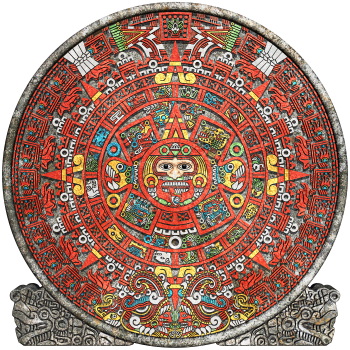ca·len·dric (-dr
 k) adj. Of, relating to, or used in a calendar.
k) adj. Of, relating to, or used in a calendar. |
| Mayan calendar |
Background
These cultures existed in Central America, near or in modern-day Oaxaca, Mexico and Guatemala. Zapotec (500 BC-1000 AD) is the oldest, followed by the Mayans (300 BC-1700 AD) and the Aztecs (1400-1600 AD).
Cycles
The calendar systems of these cultures relied heavily on cycles, which were divided into two groups: temporal and spiritual. The temporal cycle lasted 365 days; it was based on the relationship between Earth and the Sun. The spiritual cycle was 260 days and was further broken down into a 20-day cycle and a 13-day cycle
Lawrence Lo gives a great illustration of this two-part spiritual cycle:
Let's say that our day signs are the first 20 letters in the English alphabet, namely A, B, C, D, and so on, until T, and our coefficients are from 1 to 13. If today is A-1, then tomorrow is B-2, followed by C-3, and so on and so forth. When we get to M-13, at which point we have depleted all coefficients, we turn the coefficients cycle back to 1, and therefore the day after M-13 is N-1. And when we have exhausted all day signs, on day T-7, we recycle the sign cycle back to A, so the day after T-7 is A-8. When both signs and coefficients have exhausted (so that A-1 reappears), 260 days have elapsed.Get it?
The spiritual and temporal calendars were combined to create a third, 52-year cycle.
So what's the relationship of cycles and writing? "Day signs" and "day coefficients"
Each day 20-day spiritual cycle had a sign--a "day sign." Here are charts of the Zapotec, Mayan, and Aztec "day signs." What similarities do you notice?
 |
| Zapotec "day signs" |
 |
| Mayan "day signs" |
 |
| Aztec "day signs" |
Each day in the 13-day spiritual cycle has a number, or "day coefficient." The Zapotec, Mayans, and Aztecs used symbols made up of bars and dots for numbers less than 20, like this:
 |
| Bar-and-dot number symbols |
Well, the day coefficients work almost like Roman Numerals, but different. Both of them change gears a bit at five. It's interesting to see how cultures across the globe from one another are able to develop similar trains of thought.
ReplyDeleteIt's crazy that they were able to figure out the length of a year without any special technology to help them.
What was the significance of their spiritual cycle?
From what I have found, Catherine, there isn't a definitive answer to what the spiritual cycle represented, however some ideas have been hypothesized. It may be in reference to the growing season of Maize. It may have been associated with the term of a pregnancy since 260 days is about 9 months. It may also have marked times for religious rituals to be performed. Holland, I thought that the symbols and their connection to everyday objects or ideas was unique and seems to relate to other early writing systems. Another example would be the Phoenicians who used characters which nearly all represented instruments of war. Like the etymology of a word, the characters themselves give life to a culture. The Mayans had their more important references, lightning, kings and meat represented in days. We use Monday, Tuesday, etc. which are after the 7 planets in the classical knowledge.
ReplyDeleteWow! Our days are named after the 7 planets in classical knowledge? Huh! Etymology is so fascinating! I never ceased to be amazed that here we are starting out with no written language and somehow over time it develops into complex writing systems. We start with pictorial representations of things that then become characters that then become words and eventually a language.
ReplyDeleteThis kind of got me thinking about the different purposes each civilization had for creating a writing system. The clay tablets we looked at in the library were used for trade and commerce. However, in Islam writing was mainly used to preserve the words of Mahammed and other religious words. What a civilization views as important- that's what they will develop a written language to preserve. So that makes me wonder, what was most important to the Mayans, Aztecs and Zapotecs that they needed such an elaborate dating system?